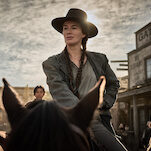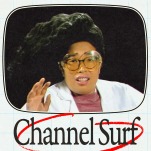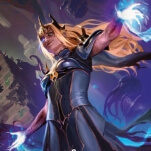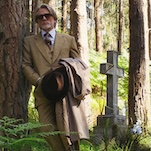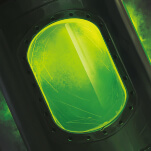So the “interloper” episode is a classic trope for any of these shows—hell, sometimes it’s a weekly thing. There are six main characters on Friends, and for the first few seasons they’re all dating heavily, so every week there’s some boyfriend or girlfriend in the mix for everyone else to overanalyze and quickly despise. The key thing about Roger (Fisher Stevens), the shrink Phoebe’s dating in “The One With The Boobies,” is that he pushes back and calls the whole gang on their problems.
Of course, Roger’s a jerk, and the joke is played out through the cute, zippy dialogue this show is so fond of. “It’s my friends; they have a liking problem with you. In that, they don’t,” Phoebe explains. He’s one of a million one-episode characters who can’t live up to the group dynamic for whatever reason. But still, he’s not without insight, and the show knows it. He pegs Chandler as an only child who suffered through divorce, using humor as a defense mechanism. He says Ross wanted his marriage to fail, that Monica eats her feelings, that the whole group is ridiculously codependent and shortsighted about their personal inadequacies.
Roger guests alongside a perfect C-plot in which Rachel desperately tries to see Chandler naked after he walks in on her coming out of the shower. It’s the hoariest of sitcom tropes, but it underlines how weird the gang’s relationship looks from the outside, especially as the situation devolves into everyone walking in on the wrong person. Roger’s probably right when he says Central Perk’s giant cups “might as well have nipples on them.”
Mostly why I prefer this storyline to the primary one is that it sticks. We can’t go on consciously thinking that Chandler is constantly acting out, because Friends was never a show that wanted us to root against its core characters. Even when a character like Ross did something horrible, he did so under semi-understandable pretenses. (“We were on a break!”) The audience can’t enjoy Friends and simultaneously realize that Monica’s just a few more failures away from an eating disorder. There have been many shows that attempted to harvest the DNA of this show Jurassic Park-style and inject such darkness into the proceedings. But come on: This is a show that uses “boobies” and “pee-pee” in its dialogue. How dark could this really get? But even if the odd love triangle introduced into Joey’s world wasn’t the focus of the show, it’s an element that didn’t get erased when the season’s 14th episode arrived. It had a permanence that Roger’s intrusion simply didn’t. I guess what I’m saying is this: Interlopers are fine and dandy when they breeze through one’s life and barely leave a dent. But when their shadow continues long after they are out of sight (or in Gloria’s case, linger despite never being in sight), then they truly make an impact.
Donna Bowman: I’m with Ryan on the Joey subplot. It undercuts the Roger storyline in a fascinating way. Joey regards Ronni as an interloper, and is stunned to find out that his mother does not. Joey insists on his dad “making things right” by restoring the family he regards as legitimate, while his mom insists that Joey “make things right” by restoring a status quo that benefits her. The nicest little touch in this switcheroo, to my mind, is Gloria’s need to know that she’s the superior party of the two women in her husband’s life. Even though she has no interest in an actual competition, it’s important to her to feel that she’s the winner.
That psychology, and the way Joey wises up to it after misreading the situation for the previous 20 minutes, forges a further connection with Phoebe’s over-analytical Roger. I love the way Fisher Stevens plays this bit. It’s not like he wants to make these observations, or mistakenly thinks that they’re welcome. He just can’t help himself. The gang practically has to drag some of these interpretations out of him. And then, the Frank Grimes-esque speech when Phoebe tries to make him feel better about not being liked: “this kind of codependent, emotionally stunted, sitting in your stupid coffeehouse…” It reveals everything. He is hurt about not being liked. And he’s been nursing a similar kind of hatred for Phoebe’s friends as they to him. If we could make a “Homer’s Enemy”-style episode about Roger, we might find out a great deal more about where that hatred comes from, and might not be as quick to laugh at Chandler’s oh-so-retro mention of Kerplunk! or Ross’s Solomonic equation of boobies with pee-pee.
Genevieve Koski: I like David’s point about Friends’ reliance on the interloper trope, particularly how it functions in a series that’s about, at least in the early going, six single people. Just mathematically speaking, that’s a lot of romantic interests coming and going over 10 seasons, much more than in something like Seinfeld (which only had four principal characters) or How I Met Your Mother (in which two of the main five are already paired off). Any given week, any one of the Friends could introduce a new entity in the form of a recent boyfriend or girlfriend, which led to a sort of revolving-door effect—at least before the show started matching the six up in various combinations over the years, eventually ending the series with two-thirds of the group paired off to one another. But even then, there were usually one or two characters who were out in the dating scene, rustling up new guest stars to come in and help drive the plot for a week. Occasionally, one of these interlopers might develop into a long-term guest star—such as Tom Selleck’s Richard, Jon Favreau’s Pete, or Helen Baxendale’s Emily—but they still remained fundamentally outsiders, doomed to be cast back into the wilderness outside the Friends’ circle once they outlived their usefulness. (The one exception is Paul Rudd’s Mike, who married Phoebe before the series’ conclusion, presumably because Joey was heading off to his own spinoff so the writers couldn’t go for the across-the-board matchup they really wanted.) And that’s not even touching on the various non-romantic interlopers the six characters brought into the mix over the years. So, just statistically speaking, any randomly chosen episode of Friends is probably more likely to feature an interloper of some kind than not.
So what is it about this episode that sticks out? Donna basically hit it on the head with the Frank Grimes comparison. Usually these come-and-go characters are walking quirks who exist solely to facilitate jokes and perhaps a little bit of conflict. But Roger exists to highlight the main characters’ flaws, to point out the annoying tendencies that everyone else on the show, and the audience, ignores or doesn’t see because of their affection for the characters. (He also subtly echoes some of the criticisms and jokes that were lobbed at Friends, particularly in its early seasons.) Granted, he does it much more amiably than Frank Grimes did, at least until his final kiss-off, but he functions in a similar, albeit much gentler, way. He shows that maybe these characters’ quirks are actually flaws deserving of the same sort of scrutiny and mockery the Friends give to anyone foolish enough to wander into their “dysfunctional group dynamic” for an episode or two. As sitcom interloping goes, that’s considerably meatier than, oh, let’s say that one guy Phoebe dated who kept letting his balls hang out of his gym shorts.
Todd VanDerWerff: Seeing this episode reminds me of something that Friends was excellent at that today’s multi-camera sitcoms seem to have mostly left behind: drama. The Big Bang Theory will do the occasional episode where somebody’s parental issues lead to a quieter, more dramatic scene, but it wouldn’t make it a big deal. The characters’ emotions are meant to be played for laughs as much as anything else on the program, and that often makes them feel a little cheap (and that’s to say nothing of all of the even worse multi-cams out there). Yet Friends was reasonably replete with scenes that took the characters’ emotions mostly seriously, often dropped into the middle of a bigger, more ridiculous plot, like everybody trying to see one another naked. Joey’s scenes with his parents are all surprisingly sweet and tender—and this at a point when the show hadn’t quite yet figured out what to do with the guy—and the more that we get to see the various permutations of the older love triangle, the more that it takes on a surprising (well, for a sitcom episode from the ’90s) emotional heft.
What I always think when watching these sorts of shows is, “Are these people going to be together forever?” It’s the disquieting notion that underwrites most hang-out sitcoms, where the friends keep doing stuff together, sometimes for up to a decade. I have plenty of friends that I’ve known for years now, but I don’t have any I spend time with every day, and I think I might worry a bit about myself if I did. There’s something weirdly disquieting about all the codependence, but the marriage subplot, interestingly enough, seems to break some of that open more. Once we see the ways Joey’s parents (and his father’s mistress) cope with how stale their relationships might have gotten over the years, the suggestion of how the Friends might deal in the years to come presents itself. I doubt any of this was intentional, but in an episode very consciously about codependence, there’s a subtle hint that it might not be the end of the world.
Erik Adams: It struck me while watching “The One With The Boobies” that the last two entries in this Roundtable theme come from early in their respective shows’ runs. “Clubhouse Poison” was only the sixth episode of My Boys; “The One With The Boobies” aired midway through Friends’ first season, when the show had gathered a healthy head of steam within the cultural zeitgeist. If Trouty is a way to test the still-forming dynamic of P.J. and friends, and if Frank Grimes (as Todd suggested) works best as a piece of television criticism, then Roger falls somewhere in between. He can’t put much of a spin on characters who are still coming together (though enough episodes would’ve aired before this one went into production that the writers would’ve heard what people thought of their program), and he hits the core cast on more of an individual level. With the gift of hindsight, it’s fascinating to see how far the characters would evolve from Roger’s readings: The traits he identifies in Monica and Chandler are fundamentals that stuck with them through the end; Ross and Rachel, meanwhile, get expositional readings on aspects of their personalities that would matter less and less as the show went on. So maybe Monica and Chandler are the more sure-footed presences 13 episodes in?
This might be a critical tool I haven’t yet honed, but the “toxic” elements of these types of ensembles never really occur to me until someone like Roger shows up and does their job. (Or when a show—like season-three Happy Endings—leans hard into the characters’ nastiness with one another.) If I may put on my fashionable-for-1995 Fisher Stevens analyst’s glasses, I think that’s a symptom of willful suspension of disbelief. We find these characters and the scrapes they get into amusing enough to look past, say, how a real group of loving, supportive friends would never enter into a farcical game of stealth “Show me yours, I’ll show you mine.” To watch a show like Friends on the regular is to buy into the codependence that Roger identifies. We get a lot out of our relationship with the show, and the only thing we have to give is 30 minutes of our time. That Friends could forge this connection with millions of viewers—and maintain such a high standard of quality, even in its first season—is pretty incredible.
Stray observations:
I love Chandler’s Speed Racer shirt that he wears to bed. [DS]
I also like Robert Costanzo’s and (especially) Brenda Vaccaro’s performances. This episode is clearly from an earlier, lower-stakes era when Friends didn’t have to cast a crazy celebrity in every guest role. [DS]
My recollection was that Matt LeBlanc did his best work as Joey in the later years of the show, when both he and the writers found new ways to spin his character and give it dimensionality. But he’s the real star of this episode, bringing wounded pride and silliness in equal measures. [RM]
The Lost fan in me is tempted to intercut this episode with “The Constant,” making “The One With The Boobies” the events that occurred inside Minkowski’s brain aboard the Kahana. [RM]
You know, if Rachel doesn’t want people looking at her breasts, she shouldn’t wear tops with a big ol’ pocket right on top of ’em. [DB]
It’s hard not to focus on the, ahem, hair and wardrobe choices when assessing whether first-season Friends had found itself yet, but actually, nearly all the characters are very confident in their voices. I don’t get Joey making tomato sauce (did he ever show any cooking skills ever again?), and Monica is a smidge too confident (although Ross’s line about marrying a lesbian to make her look good still hits home). But Ross and especially Rachel—they’re all the way there halfway through the first season. Impressive. [DB]
I nominate Fisher Stevens for Ultimate Interloper. The guy has forged a 30-year career largely out of popping up as a guest star on TV series, and by being distractingly familiar in that straight-to-video movie you’re watching for some reason. [DB]
I’d be remiss if I didn’t point out that multiple people have attempted to quantify the various paramours of the Friends gang, ranging from 85 to 138-ish over the span of the series. Those are just sexual partners, though; the number of dates/boyfriends/girlfriends/whatevers is probably more in the range of a million-billion-kerzillion. [GK]
Judging by the camera’s elegant swoop through Central Perk—and the way Gloria’s big moment looks like something beamed in from a Golden Age teleplay—I would’ve guessed this was one of the 15 Friends episodes directed by James Burrows. Turns out TV lifer Alan Myerson was at the helm of “The One With The Boobies,” his choice to give Brenda Vaccaro’s speech such visual heft more than making up for Police Academy 5: Assignment Miami Beach. [EA]
Next week: Ryan McGee invites us to Fawlty Towers for a “Waldorf Salad” and lashings of hot screwdriver. Then, Phil Dyess-Nugent accepts “No Substitutes”—only Bill Murray’s guest shot on Square Pegs will do. (“Waldorf Salad” is available for streaming from Netflix and Amazon. The Murray scenes from “No Substitute” are available on YouTube.)

